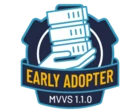Hello all,
I am looking for the documentation on 'filepeek'.
I want to do:
EXECUTE "SH -c "filepeek /path/to/file/name"
But the command 'filepeek' requires a 'Q' to quit from the prompt 'Addr:'.
I am wondering if there is a flag that I can use so that is terminates itself without the necessity of going into 'Addr:'
I am just trying to get the info on the file to see if it is 32 or 64 bit.
------------------------------
Joe Torre
Sr DBA Admin
Optum
Westerville OH United States
------------------------------
Sign up
Already have an account? Login
Welcome to the Rocket Forum!
Please log in or register:
Employee Login | Registration Member Login | RegistrationEnter your E-mail address. We'll send you an e-mail with instructions to reset your password.







